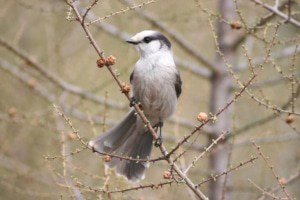| Funding: | $50,000 |
| FRIAA Participant: | Daishowa-Marubeni International Ltd. |
| Status: | Completed |
Applying new research about Alberta’s forests is an important part of FRIAA’s Forest Resource Improvement Program (FRIP). Daishowa-Marubeni International Ltd. (DMI) focuses on research that supports sustainable forest management, especially applied research that can be used in the field. Situated in Alberta’s Boreal Forest Region, DMI realized that there was little to no information about high-risk species in the region – their distribution, their specific habitat needs, their resilience to natural disturbances, and in some cases, how to recognize or identify them.
Species were being classified at various rankings of sensitivity by regulatory bodies, nationally or provincially, but in most cases, there were few resources available to properly identify what the species looked like and how to provide for its life-cycle needs. DMI was interested in learning about these high-risk species as a start-point to accommodating them through science-based forest stewardship practices, and they needed a better, Alberta-specific resource to do so.
DMI decided to undertake a voluntary project that would search scientific literature to create an easy-to-read and easy-to-use guide to recognize high-risk species in the region while providing improved awareness of forest stewardship practices opportunities. They applied for FRIP funding to help support the ambitious project that DMI was to co-fund. At the outset of the project, DMI identified 148 high-risk species for further study that were ranked of some sensitivity or rarity by international, national and provincial organizations. They hired an Edmonton consulting firm, Fiera Biological Consulting, to complete the guide. The consulting firm was tasked with sifting through current literature to discover more about high-risk species in the northwest region.
Jim Witiw, Forest Resource Coordinator – Biodiversity Stewardship at DMI, explains that the project was about collecting important information about these species because, at the time, even the most basic information was often hard to find, nor clear whether that science was of region-specific relevance. Jim says that they had to consider a variety of questions.
What does the species look like, what are its sensitivities, what do we know about it, what don’t we know about it, are there specific considerations for this species in Canada. We looked at our own practices – what are we doing well, what are some limiting factors, what should we be doing in the future. We wanted a one-stop-shop – one resource that you could pick up as a start-point to finding the answer to your question on high-risk species in northwest Alberta.”

Equally as important as gathering the information was creating information that was usable.
We made it a priority to create a document that was well designed and easy to read. The purpose of this project was to create something that a natural resource professional could use out in the field, or a high school student could use for a class project. It’s just as much for the public as it is for the forestry industry,” says Jim.
The final document was produced in a printed, digital, and waterproof field version so that it could be easily accessed by whoever needed to use it. Copies were sent to universities, high schools, public libraries, interpretive centres, public advisory committees, leading institutional organizations and natural resource professionals in northern Alberta. Project partner, Fiera, received the Alberta Society of Professional Biologists 2008 Peggy Thompson Publication Award for this work, in the category of communicating biological information to the general public.
Misinformation is a big problem today. We wanted to make a common-resource that says ‘this is what science knows,” explains Jim. “Awareness-building for enhanced appreciation of the full spectrum of high-risk species within Alberta’s northwest boreal region is a critical first step in improving the management activities or government policies that might contribute to species recovery and their persistence.”
FRIP funding was used to bring down the significant out-of-pocket cost for the project. For DMI, obtaining FRIAA funding was a simple process. “FRIAA offers very accessible funding, especially when you understand that they’re looking to fund a collection of projects that bring value to the Albertans and to as many forestry stakeholders as possible.”
The project was a success for both FRIAA and DMI, and the guide is still being used today. The complete guide is available online.
